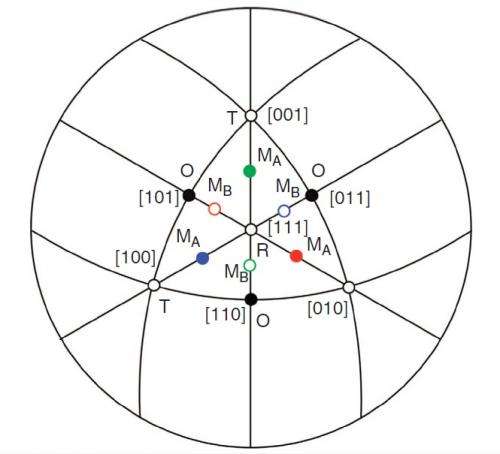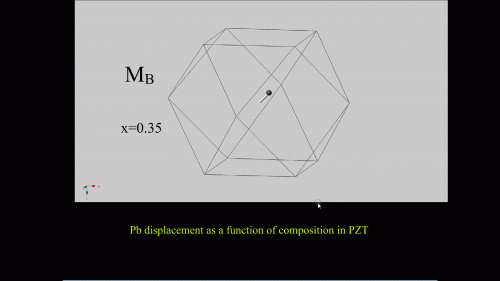A stereographic projection of a PZT crystal structure showing the displacement of certain ions. The results of the new study show how the crystal’s complex structure influences the material’s piezoelectric properties. Credit: N. Zhang, et al. ©2014 Macmillan Publishers Limited
(Phys.org) —Piezoelectric materials, which produce electricity in response to mechanical stress, account for a $12 billion global industry that is projected to grow at a rate of 13.2% per year, according to a recent report by Innovative Research and Products. And yet the origins of the widely applicable piezoelectric properties of one of the most common piezoelectric materials are not fully understood. This lack of understanding is due to the complex nature of the material's underlying crystal structure, which is responsible for its physical properties.
In a new study published in Nature Communications, a team of researchers, N. Zhang, et al., has investigated the nature of the crystal structure of lead zirconium titanate, more commonly known as PZT. Among their findings is the discovery of a boundary between two different regions of the crystal material, which has previously been predicted to exist but has not been observed until now. Understanding the nature of this "missing boundary" sheds light on what exactly makes PZT such a good piezoelectric material, and also provides insight into how to optimize its piezoelectric response.
"Because PZT is the most widely used ceramic piezoelectric, and because there are attempts to find new piezoelectrics without lead, it is important to understand why PZT works as it does and then with such information to apply this information elsewhere," coauthor Mike Glazer, Emeritus Professor at the University of Oxford, told Phys.org. "So, we have showed a mechanism that seems to highlight an important ingredient in this understanding. This work also points out that a material like this with its long and short-range order components is much more complex structurally than people originally thought."
In order to understand the significance of the boundary, the researchers explain some background on PZT. PZT is a solid solution made of lead zirconate (PbZrO3) and lead titanate (PbTiO3). It has a perovskite crystal structure (ABX3, where A is lead, B is zirconium or titanium, and X is oxygen) and occurs in an octahedral formation. One important characteristic of PZT is that the A and B ions can be slightly displaced from their primary locations in the molecular structure. If they are all displaced in the same general direction, the crystal may show polar properties, including piezoelectricity.
Animation showing that lead atoms can rotate their displacement direction within the PZT crystal structure. The more room an atom has to move, the more it is affected by an external mechanical stress, giving rise to piezoelectricity. Credit: N. Zhang, et al. ©2014 Macmillan Publishers Limited
Over the past 60 years, research on the PZT structure has revealed a high degree of structural complexity. In particular, studies have revealed the existence of a phase boundary in PZT that separates the titanium-rich region from the zirconium-rich region. A second phase boundary has been theoretically predicted to exist, since calculations have shown that the piezoelectric effect of PZT increases towards such a boundary. However, this boundary, which was predicted to lie between the zirconium-rich region and a region containing lead atoms, had not been experimentally observed until now.
In the current study, the researchers not only observed the missing boundary but also can explain why it has been so elusive and what causes the boundary to occur in the first place. They explain that the region containing lead is composed of two types of structures. In one structure, the lead atoms have a lot of space to move around, allowing them more room to be affected by an external mechanical stress. In the other structure, the lead atoms do not have nearly as much space to move. This finding indicates that the first type of structure is strongly preferable for maximizing the piezoelectric response in PZT material, helping explain why the piezoelectric response increases near this boundary. This is the first time that the important difference between these two types of structures has been understood.
The small-scale findings could have large implications for the field of piezoelectrics, which have applications including motors, sensors, and actuators. One important area of research involves trying to find new piezoelectric materials that do not contain lead, a toxic element. Currently, some lead-free piezoelectric materials can perform as well as or even better than lead-based piezoelectrics, but only in specialized applications and limited scope. Understanding the origins of piezoelectricity is an important step toward broadening the applications of lead-free piezoelectrics.
"We shall be continuing to carry out neutron and also X-ray work on PZT," Glazer said. "In particular, we are looking at single crystals of PZT grown in Vancouver with respect to the presence of what is called diffuse diffraction effects. This is important in examining the disorder (or better, the short-range order) present in PZT. I myself retired four years ago, but I continue to work on research. I do this mainly through collaboration with fellow scientists elsewhere, as I no longer have my own research group."
More information: N. Zhang, et al. "The missing boundary in the phase diagram of PbZr1-xTixO3." Nature Communications. DOI: 10.1038/ncomms6231
Journal information: Nature Communications
© 2014 Phys.org























